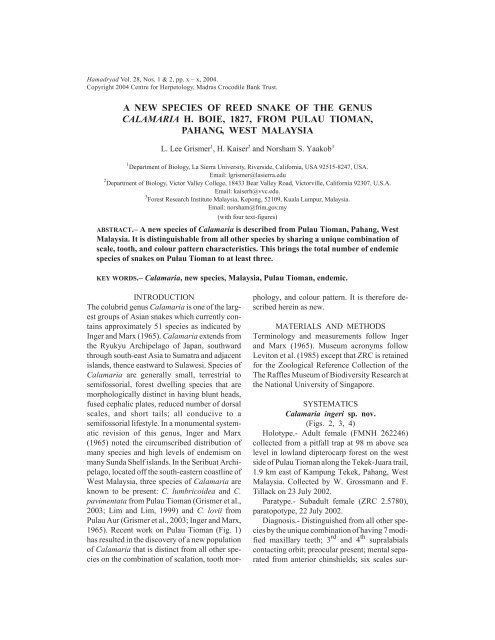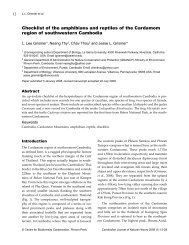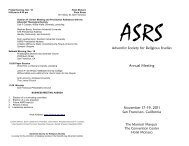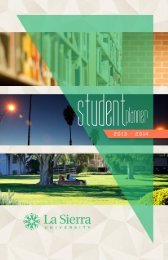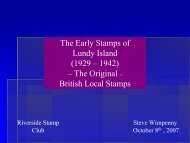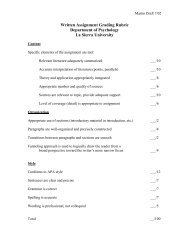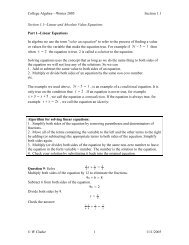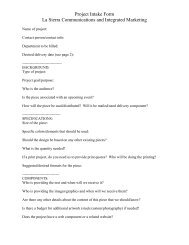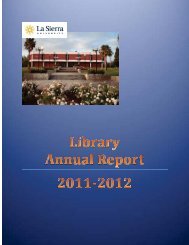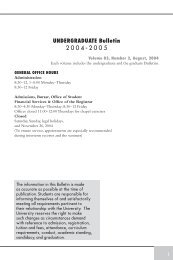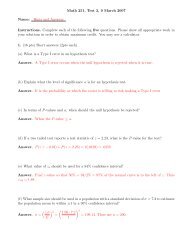a new species of reed snake of the genus calamaria h. boie, 1827 ...
a new species of reed snake of the genus calamaria h. boie, 1827 ...
a new species of reed snake of the genus calamaria h. boie, 1827 ...
You also want an ePaper? Increase the reach of your titles
YUMPU automatically turns print PDFs into web optimized ePapers that Google loves.
February, 2004] NEW CALAMARIA FROM PULAU TIOMAN 3FIGURE 2: Dorsal view <strong>of</strong> body <strong>of</strong> paratype <strong>of</strong>Calamaria ingeri sp. nov. (ZRC 2.5780), showing <strong>the</strong>banding pattern.FIGURE 3: Dorsolateral view <strong>of</strong> head <strong>of</strong> holotype <strong>of</strong>Calamaria ingeri sp. nov. (FMNH 262246).FIGURE 4: Ventral view <strong>of</strong> body <strong>of</strong> holotype <strong>of</strong>Calamaria ingeri sp. nov. (FMNH 262246), showingbelly and short tail.C. lovii lovii, C. l. gimletti, C. l. wermuthi, C.javanica, C. apraeocularis, C. alidae, C.ceramensis and C. rebentischi in not lacking apreocular scale. It differs from C. l. lovii, C. l.wermuthi, C. javanica, C. borneensis, C.battersbyi, C. melanota, C. buchi, C. linnaei, C.apraeocularis, C. curta, C. acutirostris, C.virgulata, C. forcarti, C. sumatrana, C. abstruse,C. margaritophora, C. nuchalis, C. eiselti, C.crassa, C. albiventer, C. griswoldi, C.lumbricoidea, C. hilleniusi, C. bitorques, C.prakkei, C. grevaisi, C. grabowskyi, C. suluensis,C. joloensis and C. muelleri in that <strong>the</strong> mentaldoes not contact <strong>the</strong> anterior pair <strong>of</strong> chinshields.Calamaria ingeri differs from C. schmidti, C.curta, C. acutirostra, C. leucogaster, C. ulmeriand C. lautensis in having modified maxillaryteeth. It differs from C. buchi, C. alidae, C.ceramensis, C. rebentischi, C. albiventer, C.griswoldi, C. hilleniusi, C. bitorques, C. prakkei,C. grevaisi, C. grabowskyi, C. suluensis, C.joloensis, C. muelleri, C. bicolor, C. lateralis, C.lumholtzi, C. everetti, C. brongersmai, C.palavanensis, C. leucogaster and C. ulmeri inhaving six as opposed to five shields and scalessurrounding <strong>the</strong> paraparietal. Differences in <strong>the</strong>numbers <strong>of</strong> ventrals and subcaudals are listed inTable 1.O<strong>the</strong>r material examined.- Calamarialumbricoidea BPBM 7498, LSUHC 3781 fromPulau Tioman, Pahang, West Malaysia.Calamaria pavimentata LSUHC 3920 fromPulau Tioman, Pahang, West Malaysia.Calamaria lovii gimletti ZRC 2.2684 from PulauAur, Johor, West Malaysia, ZRC 2.2686 fromBukit Lagong, Selangor, West Malaysia, ZRC2.2685 Gunung Pulai, Johor, West Malaysia.Calamaria virgulata FMNH 63571 SapagayaForest reserve, Sapagaya River, Sandakan District,Sabah, FMNH 152151-52 Mt. Kinabalu,Sabah, FMNH 212584 Lake Lindu area, Paku,central Sulawesi.DISCUSSIONCalamaria ingeri appears to be mostclosely-related to C. virgulata in having fivesupralabial scales, a preocular, high ventral scalecount (> 175), and a thick short blunt tail (Ingerand Marx, 1965). The extensive distribution andcharacter variation within C. virgulata suggestthat it may be composed <strong>of</strong> more than one <strong>species</strong>(Inger and Marx, 1965; R. F. Inger, pers. comm.,2002). In fact, <strong>the</strong> populations from central andsou<strong>the</strong>rn Sulawesi are unique in having <strong>the</strong> mentaltouching <strong>the</strong> anterior chinshields (Inger andMarx, 1965). In all o<strong>the</strong>r populations <strong>of</strong> C.virgulata, including those from Sulawesi’snor<strong>the</strong>rn peninsula, <strong>the</strong>se scales are not in contact.This pattern <strong>of</strong> variation is geographically
4 HAMADRYAD [Vol. 28, Nos. 1&2,TABLE 1: Selected diagnostic characters <strong>of</strong> <strong>the</strong> <strong>species</strong> <strong>of</strong> <strong>the</strong> <strong>genus</strong> Calamaria. 1 = supralabials contacting orbit;2 = preocular present (+) or absent (0); 3 = mental contacts chin shields (+) or not (0); 4 = maxillary teeth modified(+) or not (0); 5 = number <strong>of</strong> scales contacting paraparietal; 6 = tail tapers abruptly (+) or not (0); 7 = number <strong>of</strong>ventrals; 8 = number <strong>of</strong> subcaudals. Data on all <strong>species</strong> except C. ingeri are taken from Inger and Marx (1965).CharactersSpecies 1 2 3 4 5 6 7 8ingeri 3,4 + 0 + 6 + ?m, 213-228 f ?m, 10-11 fgracillima 2,3 0 0 + 6 0 295 m, 290-304 f 15m, 12-13 fschmidti 2,3 0 0 0 6 0 ?m, 144 f ?m, 14 flovii lovii 2 or 2,3 0 + + 6 + 190-222m, 218-254 f 17-26m, 11-18 flovii gimletti 2,3 0 0 + 6 0 161-202m, 215-249 f 14-20m, 10-12 flovii wermuthi 2,3 0 + + ? + ?m, 256 f ?m, 11 fjavanica 2,3 0 + + 6 0 176m, 168-170 f 16m, 10-12 fborneensis 2,3 + + + 6 0 126-169m, 159-192 f 20-26m, 13-21 fbattersbyi 2,3 + + + 6 + 171m, ? f 16m, ? fmelanota 2,3 + + + 6 0 121-142m, 131-154 f 23-26m, 16-20 fbuchi 2,3 + + + 5 + ?m, 221-236 f ?m, 13-14 flinnaei 2,3 + + + 6 + 130-149m, 148-166 f 15-22m, 7-13 fpavimentata 2,3 + +,0 + 5,6 0 125-168m, 137-206 f 13-33m, 8-20 fseptentrionalis 2,3 + 0 + 6 0 148-166m, 168-188 f 15-19m, 6-11 fapraeocularis 3,4 0 + + 6 0 178m, 218-220 f 18-19m, 10 falidae 3,4 0 +,0 + 5 0 185-203m, 231 f 22-27m, 17 fceramensis 3,4 0 0 + 5 0 139-146m, 148-165 f 28-30m, 17-21 frebentischi 3,4 0 0 + 5 - 140m, ? f 29m, ? fmechei 3,4 0 0 + 6 0 174m, 167-195 f 28m, 12-16 fcurta 3,4 + + 0 6 0 156m, 153-170 f 23m, 17-17 fvirgultea 3,4 + +,0 + 5,6 + 160-237m, 180-260 f 16-30m, 8-16 facutirostris 3,4 + + 0 6 0 148-162m, 163-174 f 20-24m, 13-17 fforcarti 3,4 + + + 6 0 176-177m, 194-20 f 30m, 16-17 fsumatrana 3,4 + + + 6 + 126-157m, 164-175 f 14-20m, 10-14 fabstrusa 3,4 + + + 5,6 + 129-148m, 145-152 f 24-25m, 14 fmargaritophora 3,4 + + + 6 ? 150-159m, 147-163 f 13-17m, 8-11 fnuchalis 3,4 + + + 5,6 0 133-146m, 156 f 14-20m, 9 feiselti 3,4 + + + 6 + 137m, 151-153 f 21-22m, 16-15 fcrassa 3,4 + + + 6 + 136-154m, 158-164 f 21-28m, 14-17 falbiventer 3,4 + + + 5 0 146-144m, 147-162 f 21-22m, 15-19 fgriswoldi 3,4 + + + 5 0 155-179m, 183-192 f 16-18m, 16-16 flumbricoidea 3,4 + + + 4,5 + 144-196m, 167-229 f 17-27m, 13-21 fhilleniusi 3,4 + + + 5 0 147-155m, 154-161 f 18-21m, 14-16 fbitorques 3,4 + + + 5 + 150-157m, 157-197 f 17-20m, 12-17 fprakkei 3,4 + + + 5 0 126-132m, 142-144 f 31-33m, 24-25 fgrevaisi 3,4 + + + 5 0 132-164m, 142-190 f 15-21m, 10-18 fgrabowskyi 3,4 + + + 5 0 150-186m, 164-190 f 23-29m, 20-28 fsuluensis 3,4 + + + 5 0 129-138m, 142-168 f 18-20m, 14-26 fjoloensis 3,4 + + + 5 + 199m, ? f 13m, ? fmuelleri 3,4 + + + 5 0 129-155m, 155-178 f 16-21m, 9-15 fbicolor 3,4 + 0 + 5 0 139-169m, 149-161 f 21-28m, 18-21 flateralis 3,4 + 0 + 5 0 146m, 150-151 f 23m, 16-18 f
February, 2004] NEW CALAMARIA FROM PULAU TIOMAN 5lumholtzi 3,4 +,0 0 + 5 + ?m, 161-171 f ?m, 13-15 fschlegeli 3,4 +,0 0 + 5,6 0 129-161m, 136-180 f 25-44m, 19-37 feveretti 3,4 + 0 + 5 0 140-157m, 136-155 f 20-22m, 16-25 fbrongersmai 3,4 + 0 + 5 + 155m, 157 f 18m, 11 fpalavanensis 3,4 + 0 + 5 + 171-181m, 171-187 f 23-25m, 16-20 fmodesta 3,4 + 0 + 5,6 0 131-179m, 158-202 f 19-31m, 12-21 fdoderleini 3,4 + 0 + 6 + 163m, ? f 20m, ? fboesemani 3,4 + 0 + 6 + 170m, ? f 16m, ? fleucogaster 3,4 + 0 0 5 0 126-146m, 129-157 f 17-26m, 12-19 fulmeri 3,4 + 0 0 5 0 ?m, 186 f ?m, 23+ flautensis 3,4 + 0 0 6 0 123-130m, 146 f 29-32m, 14+ fconcordant with that <strong>of</strong> o<strong>the</strong>r vertebrates onSulawesi (Evans et al., 2003) and is a result <strong>of</strong>this island being formed through <strong>the</strong> accretion <strong>of</strong>multiple islands (Hall, 1996, 1998, 2001) alongwith Pleistocene and Holocene inundations <strong>of</strong><strong>the</strong> nor<strong>the</strong>rn peninsula (Whitten et al., 2002). IfC. ingeri is related to this putative <strong>species</strong> complex,it is significant in being <strong>the</strong> only West Malaysianrepresentative. Its presence on PulauTioman and absence from peninsular Malaysia isin accordance with <strong>the</strong> biogeographic pattern <strong>of</strong>o<strong>the</strong>r populations <strong>of</strong> amphibians and reptilesfrom Pulau Tioman (Grismer et al., 2003) and isconsistent with biogeographical patterns <strong>of</strong> o<strong>the</strong>rSundaland <strong>species</strong> (Inger and Voris, 2002).The addition <strong>of</strong> Calamaria ingeri to PulauTioman brings <strong>the</strong> total <strong>of</strong> endemic amphibiansand reptiles on <strong>the</strong> island to nine: two frogs, threelizards, and four <strong>snake</strong>s (see Grismer et al., 2003and references <strong>the</strong>rein). There is at least one <strong>new</strong>frog and lizard from Pulau Tioman yet to be described.This high degree <strong>of</strong> endemism parallels<strong>the</strong> island’s high <strong>species</strong> diversity (22 frogs, onecaecilian, one turtle, 33 lizards and 38 <strong>snake</strong>s)which J. Grismer et al. (2004) attributed to PulauTioman’s complex habitat heterogeneity.ACKNOWLEDGEMENTSWe thank Sahir bin Othman, Director <strong>of</strong> Wildlife,PERHILITAN, for permission to conductfield work in <strong>the</strong> Seribuat Archipelago and PeterK. L. Ng, Chang M. Yang and Kelvin K. P. Lim(ZRC) and H. K. Voris (FMNH), for permittingus to examine material under <strong>the</strong>ir care. Wethank Robert F. Inger and Jesse L. Grismer foradvice and comments on <strong>the</strong> manuscript.LITERATURE CITEDEVANS, B. J., J. SUPRIATNA, N.ANDAYANI, M. I. SETIADI, D. C.CANNATELLA & D. J. MELNICK. 2003.Monkeys and toads define centers <strong>of</strong> endemismon Sulawesi. Evolution 57: 1436-1443.GRISMER, J. L., L. L. GRISMER, I. DAS, N.S. YAAKOB, L.-B. LIM, T.-M. LEONG, T. M.YOUMANS & H. KAISER. 2004. Species diversityand checklist <strong>of</strong> <strong>the</strong> herpet<strong>of</strong>auna <strong>of</strong> PulauTioman, Peninsular Malaysia with a preliminaryoverview <strong>of</strong> habitat utilization. AsiaticHerpetological Res 21: in press.GRISMER, L. L., I. DAS & T.-M. LEONG.2003. A <strong>new</strong> <strong>species</strong> <strong>of</strong> Gongylosoma(Squamata: Colubridae) from Pulau Tioman.Herpetologica 59(4): 567-574.________, N. S. YAAKOB, L.-B. LIM,T.-M. LEONG, I. DAS, R. A. SOSA, J. L.GRISMER, K. M. CRANE, R. E. DIAZ, S. V.FIGUEROA, C. A. LEDBETTER, S. C.NEWBOLD, S. R. NEWBOLD, C. P. PATEL, J.CASTRO, R. A. ESCOBAR, III, S.GUERRERO, J. W. PINEDO, P. JONES & H.KAISER. 2001. First report on <strong>the</strong> herpet<strong>of</strong>auna<strong>of</strong> Pulau Aur, Johor, West Malaysia. Hamadryad26: 350-353.HALL, R. 1996. Reconstructing Cenozoic SEAsia. In: Tectonic evolution <strong>of</strong> sou<strong>the</strong>ast Asia.pp: 153-184. R. Hall & D. Blundell (Eds). GeologicalSociety Special Publication No. 106.
6 HAMADRYAD [Vol. 28, Nos. 1&2,________. 1998. The plate tectonics <strong>of</strong> CenozoicSE Asia and <strong>the</strong> distribution <strong>of</strong> land andsea. In: Biogeography and geological evolution<strong>of</strong> sou<strong>the</strong>ast Asia. pp: 99-131. R. Hall & D. J.Holloway (Eds). Backhuys Publishers, Leiden.________. 2001. Cenozoic reconstructions<strong>of</strong> SE Asia and <strong>the</strong> SW Pacific: changing patterns<strong>of</strong> land and sea. In: Faunal and floral migrationsand evolution in SE Asia-Australia. pp:35-56. I. Metcalfe, J. Smith, M. Morwood & I.Davidson (Eds). Swets and Zeitlinger Publishers,Lisse.INGER, R. F. & H. MARX. 1965. The systematicsand evolution <strong>of</strong> <strong>the</strong> oriental colubrid<strong>snake</strong>s <strong>of</strong> <strong>the</strong> <strong>genus</strong> Calamaria. Fieldiana: Zool.49: 1-304.________& H. K. VORIS. 2001. Thebiogeographical relations <strong>of</strong> <strong>the</strong> frogs and <strong>snake</strong>s<strong>of</strong> Sundaland. J. Biogeogr. 28: 863–981.LEVITON, A. E., S. C. ANDERSON, R. H.GIBBS, E. HEAL JR & C. E. DAWSON. 1985.Standards in herpetology and ichthyology. Part I.Standard symbolic codes for institutional resourcecollections in herpetology and ichthyology.Copeia 1985: 802–832.LIM, K. K. P. & L. J. LIM. 1999. The terrestrialherpet<strong>of</strong>auna <strong>of</strong> Pulau Tioman, PeninsularMalaysia. Raffles Bull. Zool. Suppl. 6: 131-155.WHITTEN, T., G. S. HENDERSON & M.MUSTAFA. 2002. The ecology <strong>of</strong> Sulawesi.Periplus Editions, Hong Kong. xxx + 754 pp.Received: 9 August 2003.Accepted: 19 September 2003.


